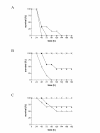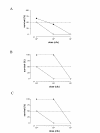The three extra-cellular zinc metalloproteinases of Streptococcus pneumoniae have a different impact on virulence in mice
- PMID: 12841855
- PMCID: PMC166150
- DOI: 10.1186/1471-2180-3-14
The three extra-cellular zinc metalloproteinases of Streptococcus pneumoniae have a different impact on virulence in mice
Abstract
Background: Streptococcus pneumoniae possesses large zinc metalloproteinases on its surface. To analyse the importance in virulence of three of these metalloproteinases, intranasal challenge of MF1 outbred mice was carried out using a range of infecting doses of wild type and knock-out pneumococcal mutant strains, in order to compare mice survival.
Results: Observation of survival percentages over time and detection of LD50s of knock out mutants in the proteinase genes in comparison to the type 4 TIGR4 wild type strain revealed two major aspects: i) Iga and ZmpB, present in all strains of S. pneumoniae, strongly contribute to virulence in mice; (ii) ZmpC, only present in about 25% of pneumococcal strains, has a lower influence on virulence in mice.
Conclusions: These data suggest Iga, ZmpB and ZmpC as candidate surface proteins responsible for pneumococcal infection and potentially involved in distinct stages of pneumococcal disease.
Figures



Similar articles
-
Zinc metalloproteinase genes in clinical isolates of Streptococcus pneumoniae: association of the full array with a clonal cluster comprising serotypes 8 and 11A.Microbiology (Reading). 2006 Feb;152(Pt 2):313-321. doi: 10.1099/mic.0.28417-0. Microbiology (Reading). 2006. PMID: 16436419
-
Pneumococcal zinc metalloproteinase ZmpC cleaves human matrix metalloproteinase 9 and is a virulence factor in experimental pneumonia.Mol Microbiol. 2003 Aug;49(3):795-805. doi: 10.1046/j.1365-2958.2003.03596.x. Mol Microbiol. 2003. PMID: 12864860
-
Establishment of a young mouse model and identification of an allelic variation of zmpB in complicated pneumonia caused by Streptococcus pneumoniae.Crit Care Med. 2008 Apr;36(4):1248-55. doi: 10.1097/CCM.0b013e318169f0c3. Crit Care Med. 2008. PMID: 18379252
-
The importance of pharmacodynamic properties in treatment of penicillin resistant Streptococcus pneumoniae.Dan Med Bull. 2000 Nov;47(5):313-27. Dan Med Bull. 2000. PMID: 11155659 Review.
-
[Investigation of pneumococcal virulence factors in the infection process].Nihon Saikingaku Zasshi. 2020;75(2):173-183. doi: 10.3412/jsb.75.173. Nihon Saikingaku Zasshi. 2020. PMID: 33361653 Review. Japanese.
Cited by
-
Characterization of the zinc metalloprotease of Streptococcus suis serotype 2.Vet Res. 2018 Oct 29;49(1):109. doi: 10.1186/s13567-018-0606-y. Vet Res. 2018. PMID: 30373658 Free PMC article.
-
The role of host and microbial factors in the pathogenesis of pneumococcal bacteraemia arising from a single bacterial cell bottleneck.PLoS Pathog. 2014 Mar 20;10(3):e1004026. doi: 10.1371/journal.ppat.1004026. eCollection 2014 Mar. PLoS Pathog. 2014. PMID: 24651834 Free PMC article.
-
Zinc metalloproteinase ZmpC suppresses experimental pneumococcal meningitis by inhibiting bacterial invasion of central nervous systems.Virulence. 2017 Nov 17;8(8):1516-1524. doi: 10.1080/21505594.2017.1328333. Epub 2017 Jun 5. Virulence. 2017. PMID: 28489958 Free PMC article.
-
Pathogenicity and virulence of Streptococcus pneumoniae: Cutting to the chase on proteases.Virulence. 2021 Dec;12(1):766-787. doi: 10.1080/21505594.2021.1889812. Virulence. 2021. PMID: 33660565 Free PMC article. Review.
-
A substrate-induced gating mechanism is conserved among Gram-positive IgA1 metalloproteases.Commun Biol. 2022 Nov 7;5(1):1190. doi: 10.1038/s42003-022-04173-3. Commun Biol. 2022. PMID: 36336763 Free PMC article.
References
-
- Gillespie SH. Aspects of pneumococcal infection including bacterial virulence, host response and vaccination. J Med Microbiol. 1989;28:237–248. - PubMed
-
- Paton JC, Andrew PW, Boulnois GJ, Mitchell TJ. Molecular analysis of the pathogenicity of Streptococcus pneumoniae: the role of pneumococcal proteins. Ann Rev Microbiol. 1993;47:89–115. - PubMed
-
- Mitchell TJ, Alexander JE, Morgan PJ, Andrew PW. Molecular analysis of virulence factors of Streptococcus pneumoniae. Soc Appl Bacteriol Symp Ser. 1997;26:62S–71S. - PubMed
-
- Mitchell TJ. Virulence factors and the pathogenesis of disease caused by Streptococcus pneumoniae. Res Microbiol. 2000;151:413–419. - PubMed
-
- Oggioni MR, Memmi G, Maggi T, Chiavolini D, Iannelli F, Pozzi G. Pneumococcal zinc metalloproteinase ZmpC cleaves human matrix metalloproteinase 9 and is a virulence factor in experimental pneumonia. Mol Microbiol. 2003;Online publication date: 23-Jun-2003 - PubMed
Publication types
MeSH terms
Substances
LinkOut - more resources
Full Text Sources
Medical
Molecular Biology Databases
Miscellaneous

